2008 MERCEDES-BENZ E-CLASS ESTATE child seat
[x] Cancel search: child seatPage 58 of 401
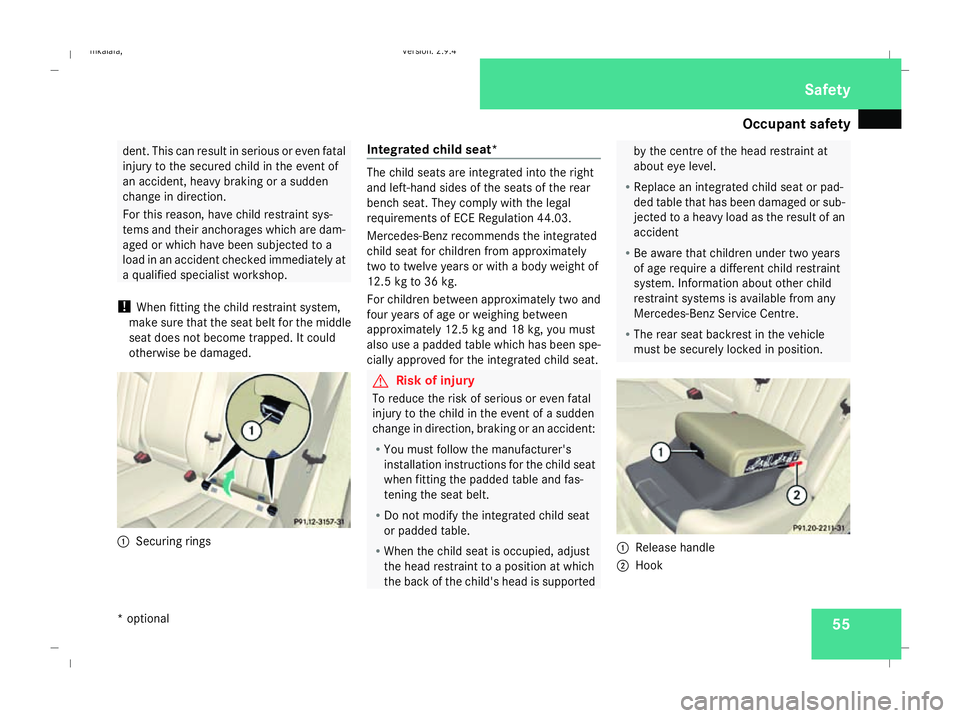
Occupant safety
55dent. This can result in serious or even fatal
injury to the secured child in the event of
an accident, heavy braking or a sudden
change in direction.
For this reason, have child restraint sys-
tems and their anchorages which are dam-
aged or which have been subjected to a
load in an accident checked immediately at
a qualified specialist workshop.
! When fitting the child restraint system,
make sure that the seat belt for the middle
seat does not become trapped. It could
otherwise be damaged. 1
Securing rings Integrated child seat* The child seats are integrated into the right
and left-hand sides of the seats of the rear
bench seat. They comply with the legal
requirements of ECE Regulation 44.03.
Mercedes-Benz recommends the integrated
child seat for children from approximately
two to twelve years or with a body weight of
12.5 kg to 36 kg.
For children between approximately two and
four years of age or weighing between
approximately 12.5 kg and 18 kg, you must
also use a padded table which has been spe-
cially approved for the integrated child seat.
G
Risk of injury
To reduce the risk of serious or even fatal
injury to the child in the event of a sudden
change in direction, braking or an accident:
R You must follow the manufacturer's
installation instructions for the child seat
when fitting the padded table and fas-
tening the seat belt.
R Do not modify the integrated child seat
or padded table.
R When the child seat is occupied, adjust
the head restraint to a position at which
the back of the child's head is supported by the centre of the head restraint at
about eye level.
R Replace an integrated child seat or pad-
ded table that has been damaged or sub-
jected to a heavy load as the result of an
accident
R Be aware that children under two years
of age require a different child restraint
system. Information about other child
restraint systems is available from any
Mercedes-Benz Service Centre.
R The rear seat backrest in the vehicle
must be securely locked in position. 1
Release handle
2 Hook Safety
* optional
211_AKB; 2; 5, en-GB
mkalafa,
Version: 2.9.4 2008-02-29T16:57:07+01:00 - Seite 55 ZDateiname: 6515_3416_02_buchblock.pdf; preflight
Page 59 of 401
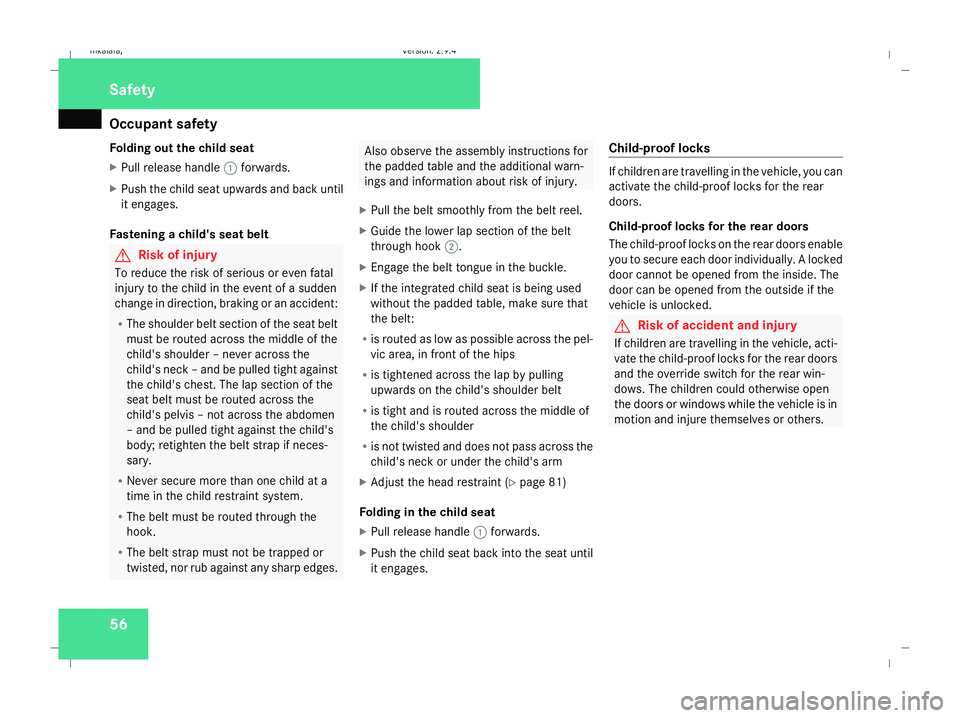
Occupant safety
56
Folding out the child seat
X
Pull release handle 1forwards.
X Push the child seat upwards and back until
it engages.
Fastening a child's seat belt G
Risk of injury
To reduce the risk of serious or even fatal
injury to the child in the event of a sudden
change in direction, braking or an accident:
R The shoulder belt section of the seat belt
must be routed across the middle of the
child's shoulder – never across the
child's neck – and be pulled tight against
the child's chest. The lap section of the
seat belt must be routed across the
child's pelvis – not across the abdomen
– and be pulled tight against the child's
body; retighten the belt strap if neces-
sary.
R Never secure more than one child at a
time in the child restraint system.
R The belt must be routed through the
hook.
R The belt strap must not be trapped or
twisted, nor rub against any sharp edges. Also observe the assembly instructions for
the padded table and the additional warn-
ings and information about risk of injury.
X Pull the belt smoothly from the belt reel.
X Guide the lower lap section of the belt
through hook 2.
X Engage the belt tongue in the buckle.
X If the integrated child seat is being used
without the padded table, make sure that
the belt:
R is routed as low as possible across the pel-
vic area, in front of the hips
R is tightened across the lap by pulling
upwards on the child's shoulder belt
R is tight and is routed across the middle of
the child's shoulder
R is not twisted and does not pass across the
child's neck or under the child's arm
X Adjust the head restraint (Y page 81)
Folding in the child seat
X Pull release handle 1forwards.
X Push the child seat back into the seat until
it engages. Child-proof locks If children are travelling in the vehicle, you can
activate the child-proof locks for the rear
doors.
Child-proof locks for the rear doors
The child-proof locks on the rear doors enable
you to secure each door individually. A locked
door cannot be opened from the inside. The
door can be opened from the outside if the
vehicle is unlocked.
G
Risk of accident and injury
If children are travelling in the vehicle, acti-
vate the child-proof locks for the rear doors
and the override switch for the rear win-
dows. The children could otherwise open
the doors or windows while the vehicle is in
motion and injure themselves or others. Safety
211_AKB; 2; 5, en-GB
mkalafa,
Version: 2.9.4 2008-02-29T16:57:07+01:00 - Seite 56Dateiname: 6515_3416_02_buchblock.pdf; preflight
Page 75 of 401

Opening and closing
72
X
Pull the boot lid/tailgate down using
recess 1.
X Lock the vehicle if necessary using
the j button on the key or with KEY-
LESS GO*.
Opening from the inside (Saloon) You can simultaneously unlock and open the
boot from the driver's seat when the vehicle
is stationary. 1
Remote opening button
X Pull remote operating button 1until the
boot lid opens.
The indicator lamp in the button lights up
and stays lit until the boot is closed again. Opening the tailgate from inside the
vehicle (Estate with a folding bench
seat*) !
The tailgate swings upwards and to the
rear when opened. Therefore, ensure that
there is sufficient clearance above and
behind the tailgate.
i You can only open the tailgate from the
inside if the child-proof locks have not been
activated (Y page 56). 1
Handle
2 Locking catch
X Pull the upper section of handle 1.
X Swing the tailgate upwards. i
The tailgate cannot be opened from the
outside if you slide locking catch 2in the
handle to the right.
Locking the boot separately (Saloon) You can lock the boot separately
14
. If you then
unlock the vehicle centrally, the boot remains
locked and cannot be opened.
X Close the boot lid.
X Remove the emergency key element from
the key (Y page 306). $
Basic position
% To lock separately
14 Not available in all countries. Controls
* optional
211_AKB; 2; 5, en-GB
mkalafa,
Version: 2.9.4 2008-02-29T16:57:07+01:00 - Seite 72Dateiname: 6515_3416_02_buchblock.pdf; preflight
Page 76 of 401

Opening and closing
73
X
Insert the emergency key element fully into
the boot lock.
X Turn the emergency key element clockwise
to position %.
X Remove the emergency key element. Boot/luggage compartment (vehicles
with remote boot lid closing feature*)
The remote boot lid closing feature* opens
and closes the boot lid/tailgate automati-
cally. You can stop the automatic opening and
closing procedure at any time:
R Saloon: by pulling or pressing the remote
operating button at the driver's seat
Estate: by pulling the remote operating but-
ton at the driver's seat again
R by pressing the ibutton on the key
R by pulling the handle on the boot lid/tail-
gate
R by pressing the closing button in the boot
lid/tailgate
On Estate vehicles, you will hear a warning
tone as the tailgate is opening or closing. G
Risk of poisoning
Exhaust fumes could enter the vehicle inte-
rior if the engine is running and the boot lid
is open. This could poison you. Therefore,
you should make sure that the boot lid/
tailgate is always closed when the engine
is running. G
Risk of accident
Estate
Do not leave children unsupervised in the
vehicle. They could open the tailgate from
the inside and thereby endanger them-
selves and others.
! The boot lid/tailgate swings upwards and
to the rear when opened. Therefore, make
sure that there is sufficient clearance
above and behind the boot lid/tailgate.
Opening from the outside You can only open the boot lid/tailgate after
unlocking it first.
X
To unlock centrally: press thekbut-
ton on the key. Saloon
1
Handle Estate
1
Handle
X Pull handle 1.
The boot lid/tailgate opens. Controls
* optional
211_AKB; 2; 5, en-GB
mkalafa,
Version: 2.9.4 2008-02-29T16:57:07+01:00 - Seite 73 ZDateiname: 6515_3416_02_buchblock.pdf; preflight
Page 80 of 401
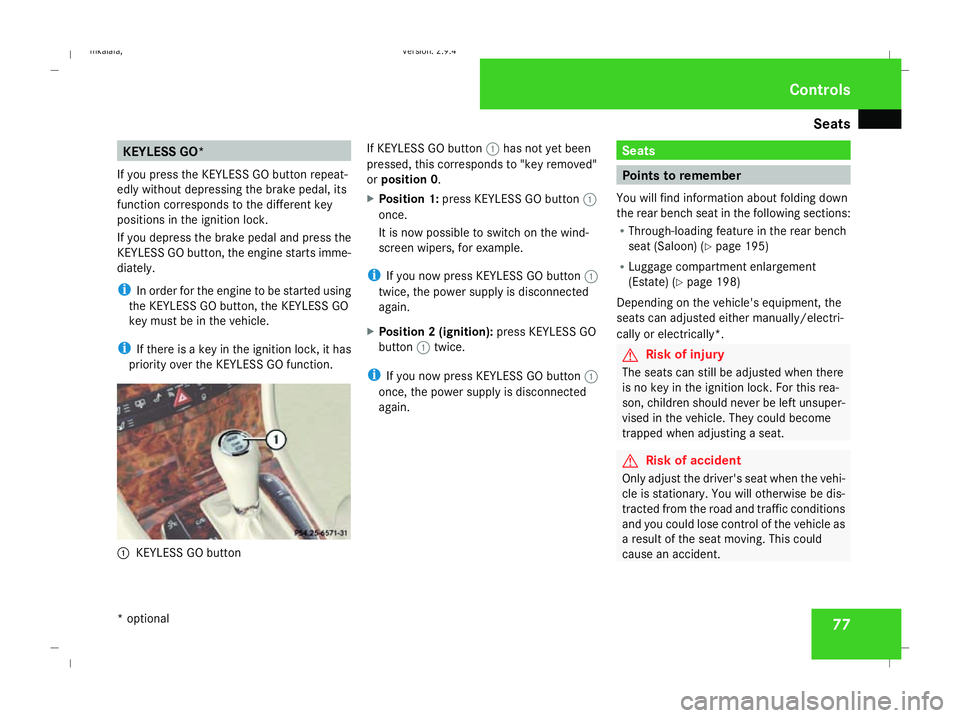
Seats
77KEYLESS GO*
If you press the KEYLESS GO button repeat-
edly without depressing the brake pedal, its
function corresponds to the different key
positions in the ignition lock.
If you depress the brake pedal and press the
KEYLESS GO button, the engine starts imme-
diately.
i In order for the engine to be started using
the KEYLESS GO button, the KEYLESS GO
key must be in the vehicle.
i If there is a key in the ignition lock, it has
priority over the KEYLESS GO function. 1
KEYLESS GO button If KEYLESS GO button
1has not yet been
pressed, this corresponds to "key removed"
or position 0.
X Position 1: press KEYLESS GO button 1
once.
It is now possible to switch on the wind-
screen wipers, for example.
i If you now press KEYLESS GO button 1
twice, the power supply is disconnected
again.
X Position 2 (ignition): press KEYLESS GO
button 1twice.
i If you now press KEYLESS GO button 1
once, the power supply is disconnected
again. Seats
Points to remember
You will find information about folding down
the rear bench seat in the following sections:
R Through-loading feature in the rear bench
seat (Saloon) (Y page 195)
R Luggage compartment enlargement
(Estate) (Y page 198)
Depending on the vehicle's equipment, the
seats can adjusted either manually/electri-
cally or electrically*. G
Risk of injury
The seats can still be adjusted when there
is no key in the ignition lock. For this rea-
son, children should never be left unsuper-
vised in the vehicle. They could become
trapped when adjusting a seat. G
Risk of accident
Only adjust the driver's seat when the vehi-
cle is stationary. You will otherwise be dis-
tracted from the road and traffic conditions
and you could lose control of the vehicle as
a result of the seat moving. This could
cause an accident. Controls
* optional
211_AKB; 2; 5, en-GB
mkalafa, Version: 2.9.4 2008-02-29T16:57:07+01:00 - Seite 77 ZDateiname: 6515_3416_02_buchblock.pdf; preflight
Page 81 of 401
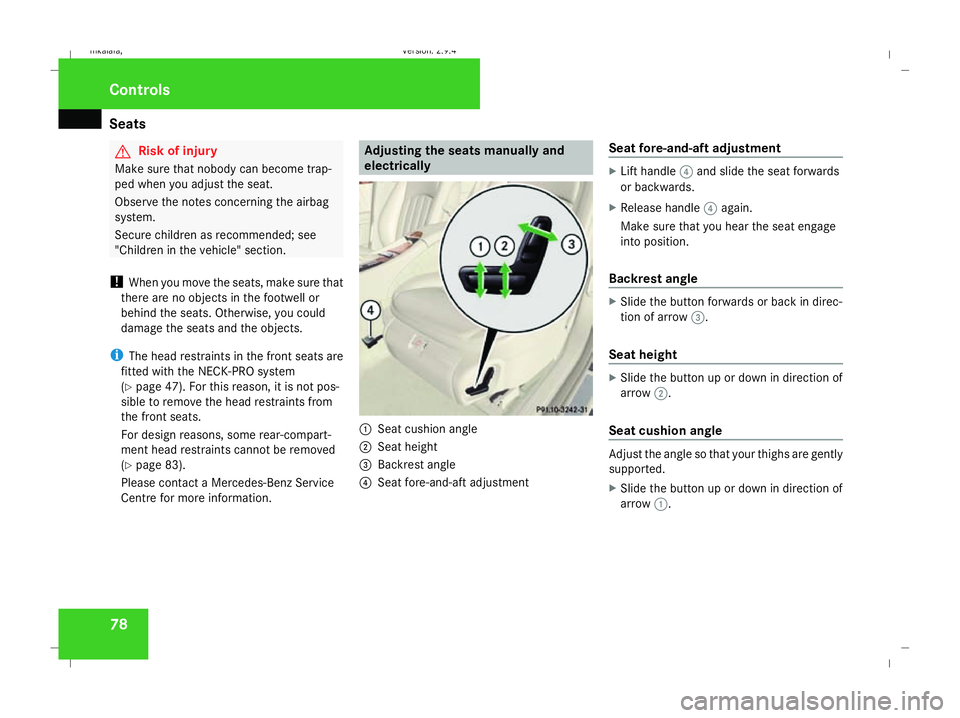
Seats
78 G
Risk of injury
Make sure that nobody can become trap-
ped when you adjust the seat.
Observe the notes concerning the airbag
system.
Secure children as recommended; see
"Children in the vehicle" section.
! When you move the seats, make sure that
there are no objects in the footwell or
behind the seats. Otherwise, you could
damage the seats and the objects.
i The head restraints in the front seats are
fitted with the NECK-PRO system
(Y page 47). For this reason, it is not pos-
sible to remove the head restraints from
the front seats.
For design reasons, some rear-compart-
ment head restraints cannot be removed
(Y page 83).
Please contact a Mercedes-Benz Service
Centre for more information. Adjusting the seats manually and
electrically 1
Seat cushion angle
2 Seat height
3 Backrest angle
4 Seat fore-and-aft adjustment Seat fore-and-aft adjustment X
Lift handle 4and slide the seat forwards
or backwards.
X Release handle 4again.
Make sure that you hear the seat engage
into position.
Backrest angle X
Slide the button forwards or back in direc-
tion of arrow 3.
Seat height X
Slide the button up or down in direction of
arrow 2.
Seat cushion angle Adjust the angle so that your thighs are gently
supported.
X Slide the button up or down in direction of
arrow 1. Controls
211_AKB; 2; 5, en-GB
mkalafa,
Version: 2.9.4 2008-02-29T16:57:07+01:00 - Seite 78Dateiname: 6515_3416_02_buchblock.pdf; preflight
Page 89 of 401

Seats
861
Rear-seat heating
i The system automatically switches down
from level 3to level 2after approximately
five minutes.
The system automatically switches down
from level 2to level 1after approximately
ten minutes.
The system automatically switches off
approximately 20 minutes after it is set to
level 1.
X Make sure that the key is in position 1or
2 in the ignition lock.
X To switch on: press button1repeatedly
until the desired heating level is set.
X To switch off: press button1repeatedly
until all indicator lamps go out. i
If the battery voltage is too low, the seat
heating may switch off. Folding bench seat in the luggage
compartment* (Estate)
i The folding bench seat in the luggage
compartment* is only suitable for persons
no more than 1.40 m tall and weighing a
maximum of 50 kg.
Secure children as recommended
(Y page 47).
The combined luggage cover and net must
be fitted if you are using the folding bench
seat. G
Risk of injury
If you are using the folding bench seat in
the luggage compartment, the backrests
on the rear bench seat must be upright and
locked.
Only start the journey once the head
restraints for the folding bench seat are
correctly positioned. Adjust the head
restraint so that the back of the seat occu-
pant's head is supported at about eye level.
This reduces the risk of injury to the child
in an accident. Make sure that the seat belt is correctly
routed across the body and that the seat
belt tongue is engaged in the buckle. G
Risk of injury
Only replace damaged covers with genuine
Mercedes-Benz covers.
Never leave children unsupervised in the
vehicle. This applies even if they are
secured by a child restraint system.
Make sure that luggage and other items are
adequately secured.
People could otherwise be injured as a
result of the load being thrown around in
the event of sharp braking, a sudden
change in direction or an accident. Controls
* optional
211_AKB; 2; 5, en-GB
mkalafa,
Version: 2.9.4 2008-02-29T16:57:07+01:00 - Seite 86Dateiname: 6515_3416_02_buchblock.pdf; preflight
Page 96 of 401
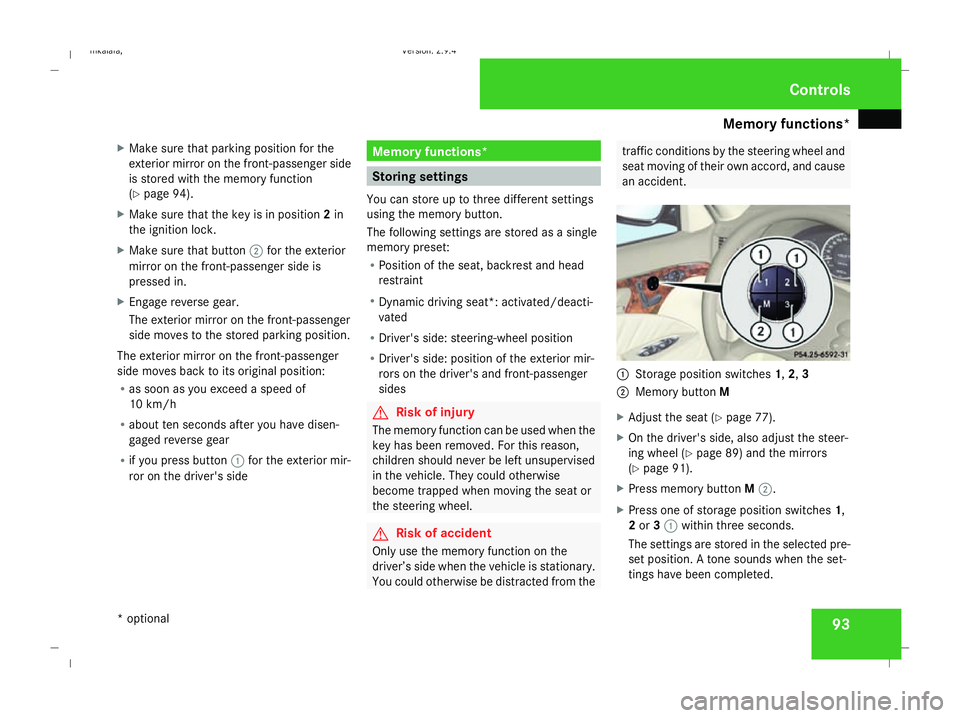
Memory functions*
93
X
Make sure that parking position for the
exterior mirror on the front-passenger side
is stored with the memory function
(Y page 94).
X Make sure that the key is in position 2in
the ignition lock.
X Make sure that button 2for the exterior
mirror on the front-passenger side is
pressed in.
X Engage reverse gear.
The exterior mirror on the front-passenger
side moves to the stored parking position.
The exterior mirror on the front-passenger
side moves back to its original position:
R as soon as you exceed a speed of
10 km/h
R about ten seconds after you have disen-
gaged reverse gear
R if you press button 1for the exterior mir-
ror on the driver's side Memory functions*
Storing settings
You can store up to three different settings
using the memory button.
The following settings are stored as a single
memory preset:
R Position of the seat, backrest and head
restraint
R Dynamic driving seat*: activated/deacti-
vated
R Driver's side: steering-wheel position
R Driver's side: position of the exterior mir-
rors on the driver's and front-passenger
sides G
Risk of injury
The memory function can be used when the
key has been removed. For this reason,
children should never be left unsupervised
in the vehicle. They could otherwise
become trapped when moving the seat or
the steering wheel. G
Risk of accident
Only use the memory function on the
driver’s side when the vehicle is stationary.
You could otherwise be distracted from the traffic conditions by the steering wheel and
seat moving of their own accord, and cause
an accident.
1
Storage position switches 1,2,3
2 Memory button M
X Adjust the seat ( Ypage 77).
X On the driver's side, also adjust the steer-
ing wheel (Y page 89) and the mirrors
(Y page 91).
X Press memory button M2.
X Press one of storage position switches 1,
2 or 31 within three seconds.
The settings are stored in the selected pre-
set position. A tone sounds when the set-
tings have been completed. Controls
* optional
211_AKB; 2; 5, en-GB
mkalafa
, Version: 2.9.4 2008-02-29T16:57:07+01:00 - Seite 93 ZDateiname: 6515_3416_02_buchblock.pdf; preflight